

Squadron Leader Roy Marsden was an RAF Navigator. He was assigned to
BRIXMIS as a Tour Officer/Russian Interpreter from 1973 to 1976.
When he was off-pass, he acted as a photographer during in flight intelligence missions
aboard a Chipmunk aircraft stationed at RAF Gatow. He explains for us the nature of the
observation flights carried out by BRIXMIS above the Berlin Control Zone.
Shortly after the end of the Second World War six Allied and Soviet Military Liaison Missions were established on the territory of the former Third Reich. The British contribution to this was known as BRIXMIS. However, after a short time liaison was not the only activity, espionage inevitably became the most important function of BRIXMIS. One of the more important and dangerous operations was the acquisition of aerial intelligence of Soviet installations in East Germany and East Berlin taking photography with hand-held cameras from a single-engined Chipmunk aircraft which was ostensibly used by the RAF for training purposes.
RAF Flying in the Berlin Control Zone
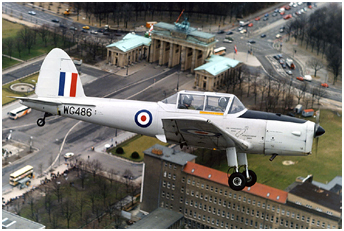
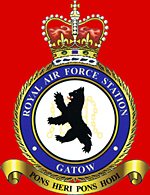 La devise de RAF Gatow : "Pons Heri Pons Hodie" se traduit par "Hier un pont, un pont aujourd'hui."
La devise de RAF Gatow : "Pons Heri Pons Hodie" se traduit par "Hier un pont, un pont aujourd'hui."
RAF Gatow motto "Pons Heri Pons Hodie" translates by "A bridge yesterday, a bridge today."
Between the years 1946 and 1990 there was in existence a highly-sensitive British intelligence unit that operated behind the Iron Curtain inside the
German Democratic Republic. The unit, generally unsung and widely unknown even with the British Armed Forces, was known as BRIXMIS,
which was a complicated acronym for the British Commanders'-in-Chief Mission to the Soviet Forces in Germany. The unit was established in 1946
as the sole means of communication between British and Soviet Commanders-in-Chief of the Zones of Occupation in Germany and was
allowed to operate from a mission house in Potsdam close to the Soviet Commander's Headquarters in Karlshorst in East Berlin.
Of course, there had to be a reciprocal arrangement with the Soviet forces whose Mission was known as SOXMIS and they were allowed to
operate within the British Zone of Occupation from Bunde close to the British Commander-in-Chief's Headquarters near Hanover. Although the
Headquarters of both Commanders-in-Chief later moved to Zossen-Wünsdorf and Rheindahlen respectively, the military missions remained in
their original locations. There were similar Soviet arrangements with France and the United States.
The British settlement, known as the Robertson-Malinin Agreement, allowed for 31 members of each Mission, at any one time to be issued with
a Soviet/British pass which gave them the "right of passage" into each other's zone of occupation. This figure, incidentally, was the highest among
the Western Allies who had only 32 passes between them, 18 to the French Military Liaison Mission (FMLM) and 14 to the United States Military
Liaison Mission (USMLM). Naturally, BRIXMIS became more than just a communication channel between Commanders-in-Chief. The realization that BRIXMIS could
observe Soviet Forces in the forward area was too good an opportunity to pass up and the Mission became a unit of highly specialized professional
soldiers, airmen and occasionally sailors. These specialists could then evaluate every aspect of the Soviet and East German Forces that would
almost certainly be in the first echelon of any attack on NATO Forces along the Inner German Border (IGB).
Many aspects of the observation of Soviet and East German Forces by BRIXMIS personnel, known esoterically as touring, have been covered
admirably in two publications. The first was called "Beyond the Front Line" by Tony Geraghty of Who Dares Wins fame and the second was "The Last
Mission" by a former BRIXMIS Army Tour Officer, Steve Gibson who was in the Mission in 1989 and 1990.

 This article is an aspect of Mission activity that has not yet been addressed concerning "Air Touring" as opposed to "Ground Touring". It
considers the difficulties of collecting clear intelligence imagery from an unstable platform as well as the more obvious dangers of flying over the
territory of East Germany (GDR) and East Berlin in a single-engined Chipmunk aircraft. It was normal practice, as a new Royal Air Force member of the
Mission, to spend the initial months "on pass" discovering the joys of touring the GDR by car. This period consisted of visits to Soviet and East
German airfields and air-ground ranges to observe and photograph flying programmes and in bad weather, visits to aviation-related ground
installations such as radar and missile sites. When this introduction was over and there was some chance that you
would recognize Soviet ground equipment, it was time to be shown touring of a completely different calibre. So after three months of touring, I gave up
my pass to another RAF tour officer. It was at this stage that I was to discover why I had been told to take my flying kit with me for what
appeared to be a ground tour with the Army. Of course I was aware that there were a couple of Chipmunk aircraft based at RAF Gatow, but like
everybody else I thought that they were for the continuation training of pilots on the station. It was therefore with some surprise that I learned that
the aircraft were also employed by BRIXMIS for Operation "Schooner/Nylon", the codewords employed in my time for an operation
that had been running since 1956 for obtaining intelligence by means of aerial photography of the dozens of Soviet and East German installations
within the Berlin Control Zone (BCZ) (1). The BCZ was established in 1945 to serve the British and US airfields in
each of their Zones of Occupation, namely Gatow in the centre and Templehof in the south. The French airport of Tegel in the north, was built only in 1948.
The BCZ was connected to West Germany by means of the three air corridors. The width of the air corridors and the radius of the zone was established as 20
statute miles (17.4 nms - 32 km), which odd non-aviation figure was chosen by the British delegation at the talks to decide the future of Berlin,
led by Field-Marshal Montgomery. When he was asked during the talks what sort of miles they should be, he replied testily that they should of course be British miles.
This article is an aspect of Mission activity that has not yet been addressed concerning "Air Touring" as opposed to "Ground Touring". It
considers the difficulties of collecting clear intelligence imagery from an unstable platform as well as the more obvious dangers of flying over the
territory of East Germany (GDR) and East Berlin in a single-engined Chipmunk aircraft. It was normal practice, as a new Royal Air Force member of the
Mission, to spend the initial months "on pass" discovering the joys of touring the GDR by car. This period consisted of visits to Soviet and East
German airfields and air-ground ranges to observe and photograph flying programmes and in bad weather, visits to aviation-related ground
installations such as radar and missile sites. When this introduction was over and there was some chance that you
would recognize Soviet ground equipment, it was time to be shown touring of a completely different calibre. So after three months of touring, I gave up
my pass to another RAF tour officer. It was at this stage that I was to discover why I had been told to take my flying kit with me for what
appeared to be a ground tour with the Army. Of course I was aware that there were a couple of Chipmunk aircraft based at RAF Gatow, but like
everybody else I thought that they were for the continuation training of pilots on the station. It was therefore with some surprise that I learned that
the aircraft were also employed by BRIXMIS for Operation "Schooner/Nylon", the codewords employed in my time for an operation
that had been running since 1956 for obtaining intelligence by means of aerial photography of the dozens of Soviet and East German installations
within the Berlin Control Zone (BCZ) (1). The BCZ was established in 1945 to serve the British and US airfields in
each of their Zones of Occupation, namely Gatow in the centre and Templehof in the south. The French airport of Tegel in the north, was built only in 1948.
The BCZ was connected to West Germany by means of the three air corridors. The width of the air corridors and the radius of the zone was established as 20
statute miles (17.4 nms - 32 km), which odd non-aviation figure was chosen by the British delegation at the talks to decide the future of Berlin,
led by Field-Marshal Montgomery. When he was asked during the talks what sort of miles they should be, he replied testily that they should of course be British miles.
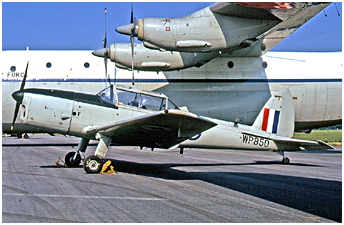
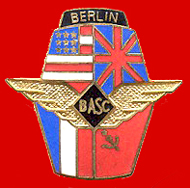 These air corridors and the BCZ were the
only access by air to West Berlin, outside of them was East German airspace from which all air traffic was banned as there was always the distinct
possibility of some sort of entanglement with Soviet fighters. The focus of the BCZ was the original Four-Power Komandatura
building in the centre of Berlin from where the administration of the city was carried on. However, the Soviets pulled out from the arrangement and
precipitated the crisis that led to the Berlin Airlift in 1948 and 1949. But, interestingly enough, the air traffic element of the Soviet Headquarters
remained and in fact the Four-Power Berlin Air Safety Centre (BASC)
was in being until 1990 when all the airspace reverted to German control (2). BASC
was basically the focus of all air traffic control movements in and out of Berlin; the centre authorized all flights both military and civil along the
three air corridors to West Berlin and the four air corridors to East Berlin. At RAF Gatow, the Chipmunks were flown, as I said earlier, regularly
for continuation training, but for five days in every two weeks they were primarily available for the use of BRIXMIS to carry out aerial photography
in the BCZ. This was a purely RAF operation which included not only the BRIXMIS personnel but also pilots from the station. The Army had tried to
take a more active part in the operation but were finally convinced that if they were not used to flying in small aircraft they would, in the case of an
emergency, be a serious liability since they lacked the necessary airmanship skills.
However, had the flights been only "circuit bashing", it would have been obvious to the Soviets that every flight outside the immediate area of RAF
Gatow was a "spy flight" had it not been for the fact that the Station QFI (Qualified Flying Instructor) used to fly almost daily covering similar routes
and procedures as the BRIXMIS photographic flights. The QFI would always, for example, fly the aircraft from the back seat and carry a
passenger in the front seat. This would occasionally attract the same sort of attention as the BRIXMIS flights as on one occasion when a Soviet Mi-24
helicopter "Hind" closely followed the Chipmunk in the area of the Soviet helicopter base at Oranienburg to the north of Berlin and chased it for some
time before overtaking the aircraft and cheerily waving to the pilot. The cover story that the Chipmunk was purely for the training of pilots on the
station would therefore have been reinforced had the Chipmunk been forced to land in Soviet territory when the aircraft was "clean", with only RAF
Gatow personnel on board. It could have been a big embarrassment for the Soviets who were convinced that it was at all times up to no good.
Since the operation was Top Secret, there was a great deal of effort put into concealing the purpose of the flights.
These air corridors and the BCZ were the
only access by air to West Berlin, outside of them was East German airspace from which all air traffic was banned as there was always the distinct
possibility of some sort of entanglement with Soviet fighters. The focus of the BCZ was the original Four-Power Komandatura
building in the centre of Berlin from where the administration of the city was carried on. However, the Soviets pulled out from the arrangement and
precipitated the crisis that led to the Berlin Airlift in 1948 and 1949. But, interestingly enough, the air traffic element of the Soviet Headquarters
remained and in fact the Four-Power Berlin Air Safety Centre (BASC)
was in being until 1990 when all the airspace reverted to German control (2). BASC
was basically the focus of all air traffic control movements in and out of Berlin; the centre authorized all flights both military and civil along the
three air corridors to West Berlin and the four air corridors to East Berlin. At RAF Gatow, the Chipmunks were flown, as I said earlier, regularly
for continuation training, but for five days in every two weeks they were primarily available for the use of BRIXMIS to carry out aerial photography
in the BCZ. This was a purely RAF operation which included not only the BRIXMIS personnel but also pilots from the station. The Army had tried to
take a more active part in the operation but were finally convinced that if they were not used to flying in small aircraft they would, in the case of an
emergency, be a serious liability since they lacked the necessary airmanship skills.
However, had the flights been only "circuit bashing", it would have been obvious to the Soviets that every flight outside the immediate area of RAF
Gatow was a "spy flight" had it not been for the fact that the Station QFI (Qualified Flying Instructor) used to fly almost daily covering similar routes
and procedures as the BRIXMIS photographic flights. The QFI would always, for example, fly the aircraft from the back seat and carry a
passenger in the front seat. This would occasionally attract the same sort of attention as the BRIXMIS flights as on one occasion when a Soviet Mi-24
helicopter "Hind" closely followed the Chipmunk in the area of the Soviet helicopter base at Oranienburg to the north of Berlin and chased it for some
time before overtaking the aircraft and cheerily waving to the pilot. The cover story that the Chipmunk was purely for the training of pilots on the
station would therefore have been reinforced had the Chipmunk been forced to land in Soviet territory when the aircraft was "clean", with only RAF
Gatow personnel on board. It could have been a big embarrassment for the Soviets who were convinced that it was at all times up to no good.
Since the operation was Top Secret, there was a great deal of effort put into concealing the purpose of the flights.
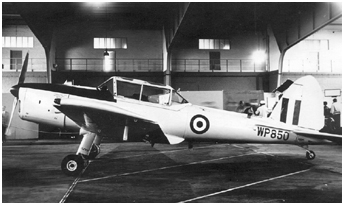
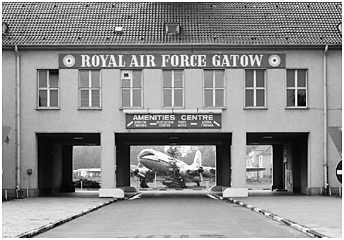 For a start, the BRIXMIS
personnel involved in the flights drove to Gatow in an ordinary RAF staff car as a tour car would have been something of a give-away to the
"watchers" that were often to be seen hanging around the entrance to the station. BRIXMIS flashes were not worn on uniforms and any camera
equipment was hidden. The Chipmunks were kept in a hangar and the crew would get in the aircraft while it was still in the hangar, also to avoid any
prying eyes. This was important as it gave us the opportunity to prepare all the necessary camera equipment and films. When I started, I carried two
camera bodies one with either a 55mm or a 180mm lens and the other with a 500mm lens for close-up photography. In fact I got used to carrying and
using a 1,000mm lens which allowed me very little room in the front cockpit even with the canopy open as you could not rest the camera on the
fuselage to take photographs owing to the vibration and the lens had to stick out into the slipstream and with a lens of this size any slight movement
would be translated into out-of-focus photographs and had to be used sparingly. In the bitter Berlin winter, despite several layers of clothes, it was
extremely cold and photography became even more difficult, especially changing films. It was amazing that after a two-hour flight both crew
members were not suffering from frostbite. Pre-flight checks completed, the aircraft was pushed out onto the apron
for start-up with the crew already strapped in so as to make identification of that crew difficult for any photographer taking pictures with a long lens.
For all these flights, the pilot sat in the rear seat and the photographer sat in the front. Then came the daunting and dangerous task of flying a single
engined aircraft within the 1,200 square miles of the BCZ over many major Soviet and East German installations.
For a start, the BRIXMIS
personnel involved in the flights drove to Gatow in an ordinary RAF staff car as a tour car would have been something of a give-away to the
"watchers" that were often to be seen hanging around the entrance to the station. BRIXMIS flashes were not worn on uniforms and any camera
equipment was hidden. The Chipmunks were kept in a hangar and the crew would get in the aircraft while it was still in the hangar, also to avoid any
prying eyes. This was important as it gave us the opportunity to prepare all the necessary camera equipment and films. When I started, I carried two
camera bodies one with either a 55mm or a 180mm lens and the other with a 500mm lens for close-up photography. In fact I got used to carrying and
using a 1,000mm lens which allowed me very little room in the front cockpit even with the canopy open as you could not rest the camera on the
fuselage to take photographs owing to the vibration and the lens had to stick out into the slipstream and with a lens of this size any slight movement
would be translated into out-of-focus photographs and had to be used sparingly. In the bitter Berlin winter, despite several layers of clothes, it was
extremely cold and photography became even more difficult, especially changing films. It was amazing that after a two-hour flight both crew
members were not suffering from frostbite. Pre-flight checks completed, the aircraft was pushed out onto the apron
for start-up with the crew already strapped in so as to make identification of that crew difficult for any photographer taking pictures with a long lens.
For all these flights, the pilot sat in the rear seat and the photographer sat in the front. Then came the daunting and dangerous task of flying a single
engined aircraft within the 1,200 square miles of the BCZ over many major Soviet and East German installations.
notes
(1) The operation was finally renamed "Oberon."
(2) The BASC was officially closed on December 31, 1990. However, it remained operational after the
German unification due to a shortage of German Air Traffic Controllers but France withdrew from the organisation.
 |
Safety of Flight not Garanteed > Part 2 > Part 3 > Part 4 |
 |
Plan du site - Sitemap |  |
